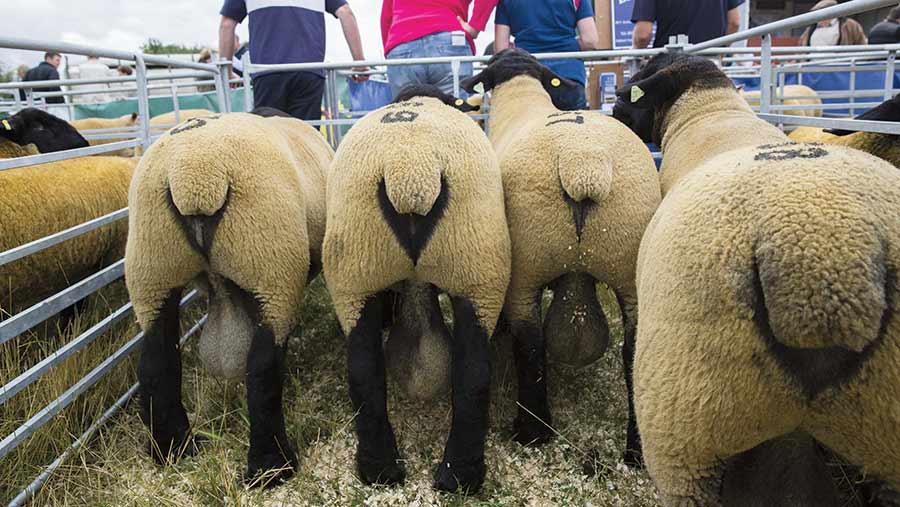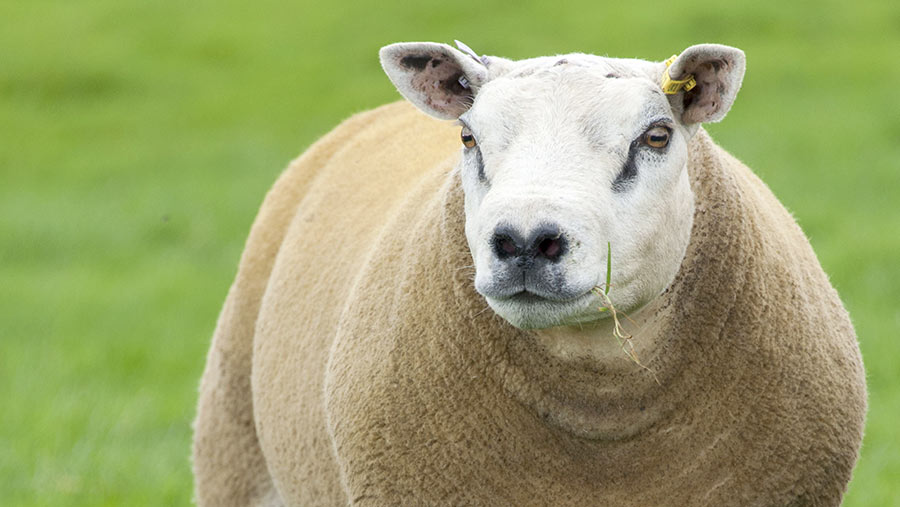Advice on buying a ram: What to look for
 © David Hartley/REX/Shutterstock
© David Hartley/REX/Shutterstock As the main ram buying period draws near, selecting tups that have the potential to improve performance and profitability is a priority for commercial sheep producers.
Rams play a crucial role in flock performance so selecting animals that complement the system is one of the most important decisions a sheep farmer will make during the year.
We examine some of the criteria farmers need to consider.
See also: 6 ways to make your teaser rams work for you
Estimated breeding values (EBVs) – what to look out for
EBVs, which predict the breeding merit of an animal for a specific trait by analysing pedigree and performance data, are an important tool for selecting a ram to add value to a flock.
The priorities producers place on different traits will depend on their current flock performance, says Sam Boon of Signet.
He suggests the use of EBVs when selecting maternal sires is even more important than when selecting terminal sires.
“Traits of interest can’t be assessed visually and the attributes passed on should remain in the flock for many years, being passed from generation to generation through the female replacements retained,’’ he says.
Maternal traits to consider
Most flocks, says Mr Boon, will seek positive breeding values for eight-week weight, litter size and maternal ability to influence early lamb growth rates, the number of lambs reared and milking ability of female replacements.
“Many Signet recorded flocks are ultrasound-scanned, so breeding values for traits influencing carcase conformation are also available and should be taken into account,’’ he says.
In recent years, there has been a series of new traits introduced for specific breeds where large datasets exist.
For instance, the Lleyn and Scottish Blackface now have EBVs for lamb survival, a trait that has high economic importance to commercial producers but has historically been challenging to enhance as genetic influences on the trait tend to be low.
“Recent AHDB-funded work has developed new approaches to assessing the trait, looking at the entire flock and deducing which lambs survived from their subsequent weight records – finding significant genetic differences between sires that is worth exploiting,’’ he believes.
Another economically important trait is ewe longevity – again, the Lleyn breed, which records over 20,000 lambs with Signet each year, has provided a dataset from which new breeding values can be derived.
“Genetic influences on longevity again tend to be low but the value of this trait to producers can be highly significant and is well worth consideration,’’ he advises.
“The trait takes into account the length of time when the ewe is productive in the flock, so is actually an indicator of reproductive lifespan within the flock.’’
Terminal traits to consider
For terminal sires, the industry’s commercial progeny test, RamCompare, has yielded new breeding values for carcase weight, conformation and fat class.
The work has shown that current EBVs are a good predictor of overall carcase merit, with producers advised to select rams with high EBVs for scan weight and muscle depth to enhance growth and carcase attributes.
But, of real interest, says Mr Boon, is the closer relationship observed between the CT lean weight EBV, an estimated breeding value derived from the use of CT scanning to predict the yield of meat in the carcase and carcase weight.
There are clear differences between rams with similar characteristics for on-farm growth rate in their ability to convert this into carcase weight.
Therefore, producers selling on a deadweight basis would be well advised to take breeding values, scan weight and CT lean weight into account, he recommends.
Avoid overfed rams
Many rams are over-fat because they have been intensively fed concentrates before being offered for sale so selecting on performance rather than looks is essential.
The biggest rams might look the most appealing, but are often unfit for breeding in their first year and their future performance can be compromised.
“These rams are fed many kilograms of concentrates and if that feeding regime is not maintained they are not able to cope in a grazing situation when they get out with the ewes.
“This has an effect on their reproductive and physical ability,’’ warns independent sheep consultant Lesley Stubbings.
She is an advocate of sourcing rams direct from the farm rather than a market.
A survey she conducted as part of her Animal Welfare Fund study into the welfare and longevity of rams in commercial sheep flocks showed that a higher percentage of buyers were more satisfied with their purchase after buying direct from a breeder.
“If you buy off farm it is much easier to talk about how a ram has been fed and to look at how he should be managed once you get him home,’’ Ms Stubbings suggests.
“In a market, what tends to happen is that the buyer selects the animals that look the fittest and the biggest, but unfortunately those are often the ones that have been pushed hardest on concentrates.
“We know there can be a vast difference between what a ram looks like and its underlying genetics, so buying decisions should be based on EBVs, health and fitness for breeding, not how big he looks in the sale ring.’’

Texel ram © FLPA REX/Shutterstock
Fit, not fat
Body condition scoring is very useful for rams as well as ewes. Ms Stubbings advises scoring rams before purchase, aiming for score 3.5-4, which is a good covering of fat over the loin and the backbone can be felt with firm pressure.
Too fat and a ram may have less libido; excess fat in the scrotum can also decrease fertility. Too thin and he might not manage to serve all the ewes.
Ram MOT
A ram MOT should cover teeth, toes, tone, testicles and treatments, says sheep vet Phillipa Page of Flock Health.
Teeth and mouth: Check incisor and molar teeth. There should be no spiky or missing teeth. Lumps along the jawline could be a sign of a tooth rot abscess.
Neck/head/shoulders: Check for wounds from fighting or signs of Caseous Lymphadenitis (CLA), chronic abscesses that occur in the superficial lymph nodes.
Body condition: See above.
Brisket: Pay attention to sores from raddles.
Penis/sheath: Check that the sheath is clear of infection, with no sign of shearing damage, and that the penis can be extracted.
Legs and feet: Rams need sound feet to work well – infections reduce fertility due to raised body temperature.
Testes: Sperm takes six to eight weeks to be produced and to mature before tupping so ideally rams need assessing 10 weeks pre-tupping. Testes should be firm but springy and a good size. Check for lumps, adhesions and evenness in size.
Measure scrotal circumference: AHDB has resources and tape measures for this. Minimum standards for a shearling ram are 32cm for lowland breeds and 30cm for hill breeds.
Vaccination
Ms Page recommends checking vaccination records – a ram should be vaccinated for pasteurella and clostridial disease, both common causes of sudden death in sheep but preventable by vaccination.
“Make sure your rams are vaccinated at the same time as your ewes to ensure that they don’t get missed. They need two injections two to four weeks apart as the first course,’’ says Ms Page.
“We still see expensive rams die due to pasteurella and clostridial disease, usually because the rams get overlooked.’’
Rams may have been vaccinated before arriving on the farm but the farmer needs to know when and to make sure future vaccinations fit in with the farm’s own routine so they are not overlooked.
“I prefer that they vaccinate incoming rams themselves so that they are confident that they are covered,’’ says Ms Page.
Checklist
- Traits of interest can’t be assessed visually – check EBVs
- Source rams direct from the farm if possible
- Ask questions about the type of diet rams are being fed
- Rams must be fit but not fat
- Check vaccination records
